Report on Supporting Individual Journeys Through Integrated Care
VerifiedAdded on 2020/10/05
|8
|1975
|96
Report
AI Summary
This report provides a comprehensive overview of integrated health and social care, focusing on the individual journey within the healthcare system. It examines local resources and provisions that support integrated care working, including care coordination, cultural competence, and long-term services. The report identifies local unmet needs in healthcare, particularly in Leeds, highlighting issues such as lack of specialized staff and equipment. It differentiates between social care and healthcare providers, outlining the roles of each and the types of interagency care provision. The report also explores local resources for meeting individual needs, emphasizing multidisciplinary care and member engagement. The conclusion summarizes the importance of integrated care in improving health conditions and fulfilling unmet needs, referencing key literature to support its findings.
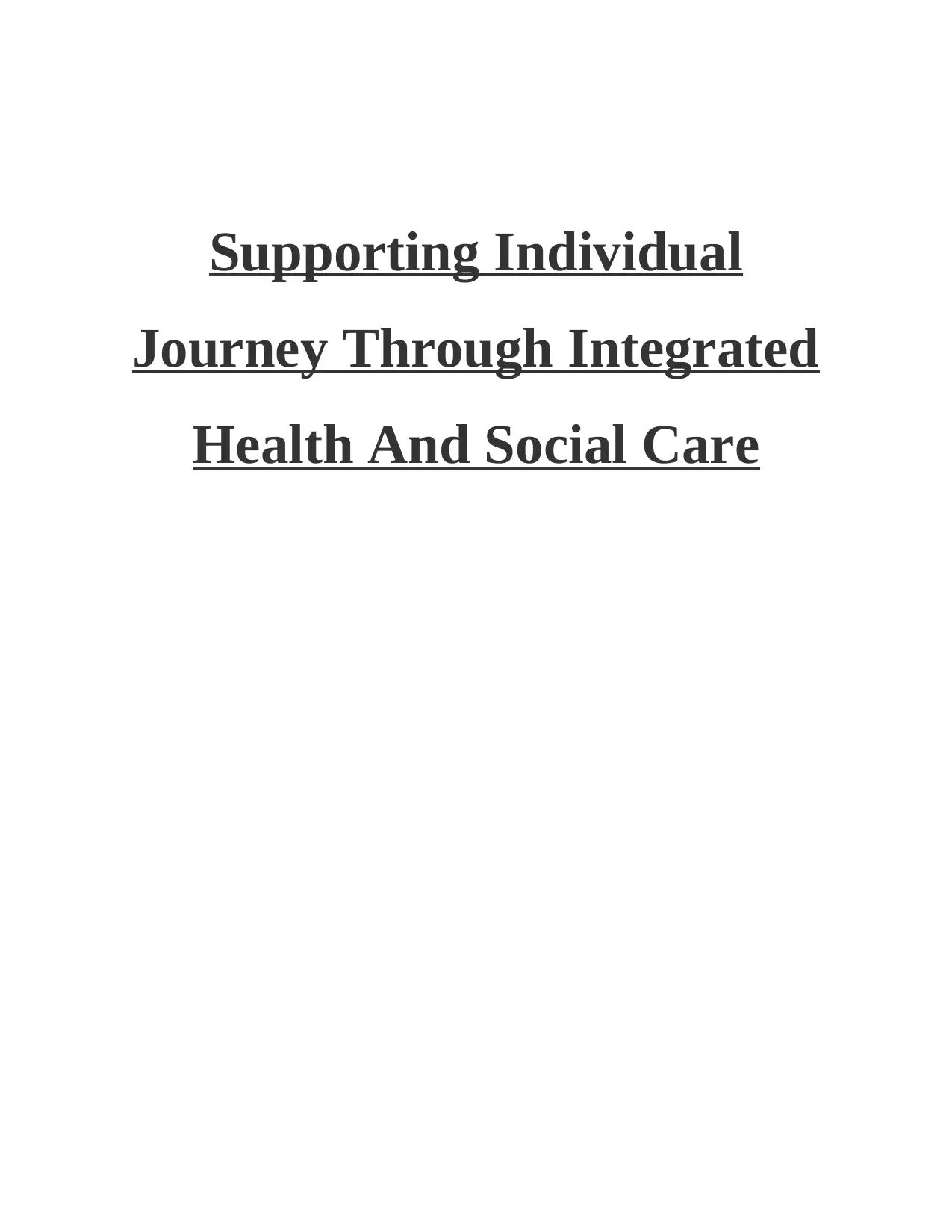
Supporting Individual
Journey Through Integrated
Health And Social Care
Journey Through Integrated
Health And Social Care
Paraphrase This Document
Need a fresh take? Get an instant paraphrase of this document with our AI Paraphraser
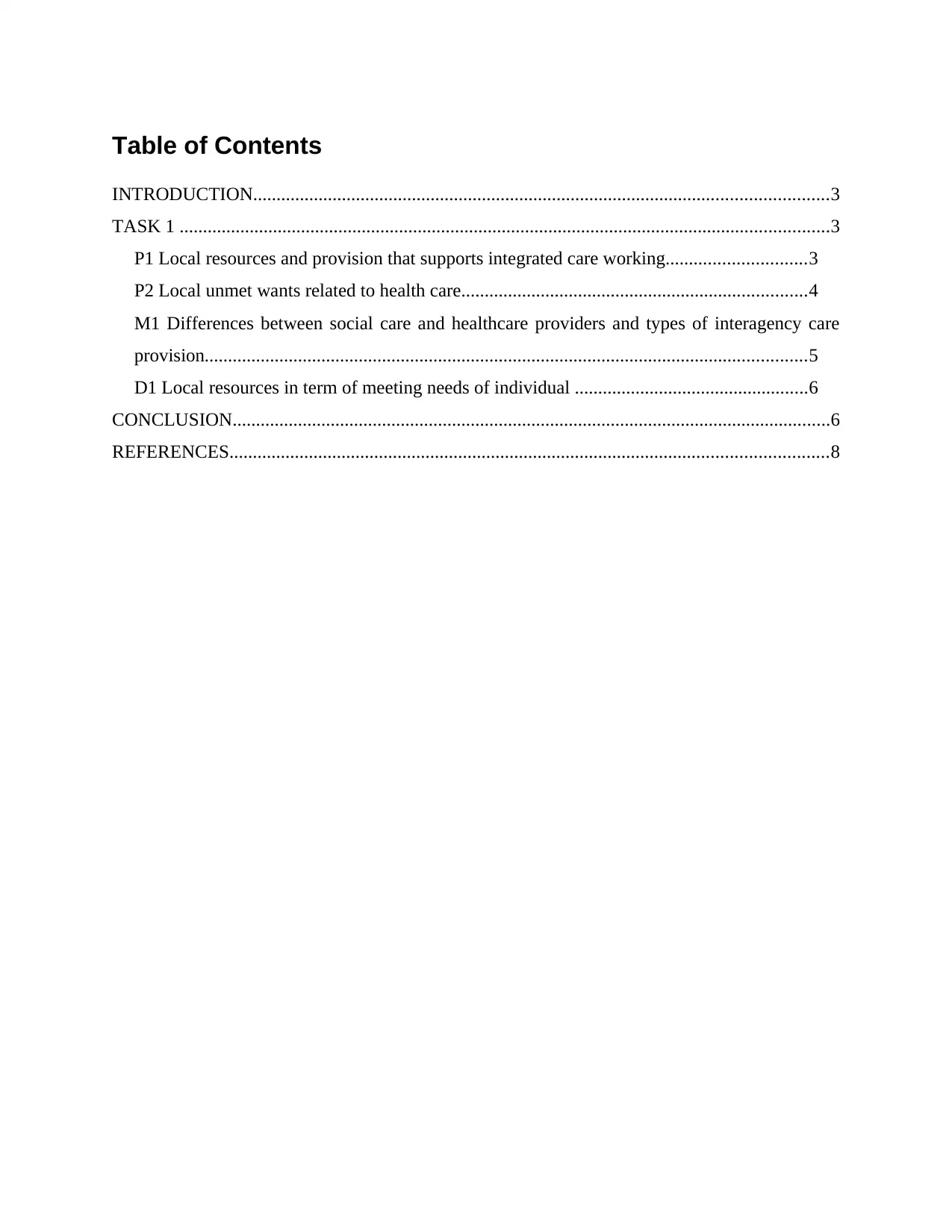
Table of Contents
INTRODUCTION...........................................................................................................................3
TASK 1 ...........................................................................................................................................3
P1 Local resources and provision that supports integrated care working..............................3
P2 Local unmet wants related to health care..........................................................................4
M1 Differences between social care and healthcare providers and types of interagency care
provision.................................................................................................................................5
D1 Local resources in term of meeting needs of individual ..................................................6
CONCLUSION................................................................................................................................6
REFERENCES................................................................................................................................8
INTRODUCTION...........................................................................................................................3
TASK 1 ...........................................................................................................................................3
P1 Local resources and provision that supports integrated care working..............................3
P2 Local unmet wants related to health care..........................................................................4
M1 Differences between social care and healthcare providers and types of interagency care
provision.................................................................................................................................5
D1 Local resources in term of meeting needs of individual ..................................................6
CONCLUSION................................................................................................................................6
REFERENCES................................................................................................................................8
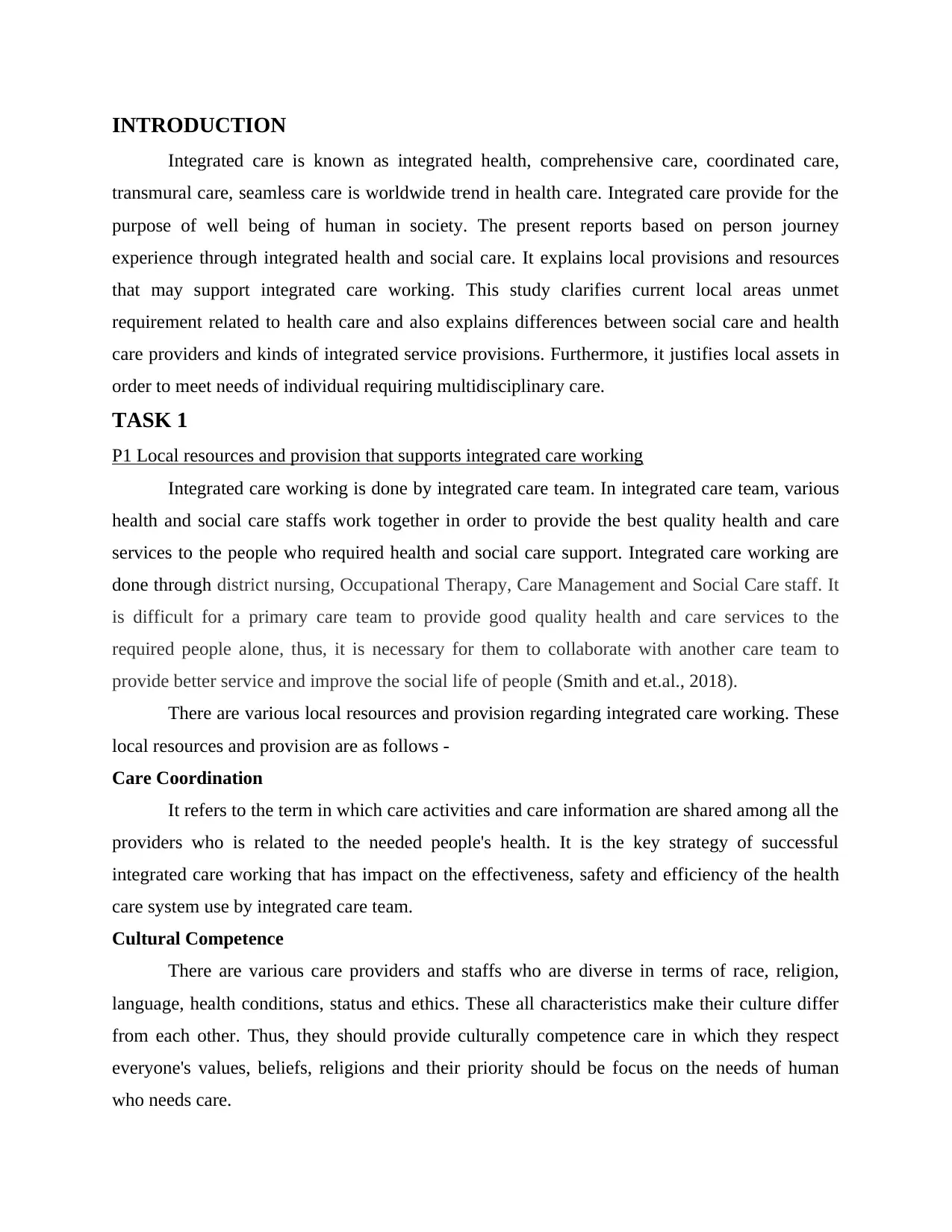
INTRODUCTION
Integrated care is known as integrated health, comprehensive care, coordinated care,
transmural care, seamless care is worldwide trend in health care. Integrated care provide for the
purpose of well being of human in society. The present reports based on person journey
experience through integrated health and social care. It explains local provisions and resources
that may support integrated care working. This study clarifies current local areas unmet
requirement related to health care and also explains differences between social care and health
care providers and kinds of integrated service provisions. Furthermore, it justifies local assets in
order to meet needs of individual requiring multidisciplinary care.
TASK 1
P1 Local resources and provision that supports integrated care working
Integrated care working is done by integrated care team. In integrated care team, various
health and social care staffs work together in order to provide the best quality health and care
services to the people who required health and social care support. Integrated care working are
done through district nursing, Occupational Therapy, Care Management and Social Care staff. It
is difficult for a primary care team to provide good quality health and care services to the
required people alone, thus, it is necessary for them to collaborate with another care team to
provide better service and improve the social life of people (Smith and et.al., 2018).
There are various local resources and provision regarding integrated care working. These
local resources and provision are as follows -
Care Coordination
It refers to the term in which care activities and care information are shared among all the
providers who is related to the needed people's health. It is the key strategy of successful
integrated care working that has impact on the effectiveness, safety and efficiency of the health
care system use by integrated care team.
Cultural Competence
There are various care providers and staffs who are diverse in terms of race, religion,
language, health conditions, status and ethics. These all characteristics make their culture differ
from each other. Thus, they should provide culturally competence care in which they respect
everyone's values, beliefs, religions and their priority should be focus on the needs of human
who needs care.
Integrated care is known as integrated health, comprehensive care, coordinated care,
transmural care, seamless care is worldwide trend in health care. Integrated care provide for the
purpose of well being of human in society. The present reports based on person journey
experience through integrated health and social care. It explains local provisions and resources
that may support integrated care working. This study clarifies current local areas unmet
requirement related to health care and also explains differences between social care and health
care providers and kinds of integrated service provisions. Furthermore, it justifies local assets in
order to meet needs of individual requiring multidisciplinary care.
TASK 1
P1 Local resources and provision that supports integrated care working
Integrated care working is done by integrated care team. In integrated care team, various
health and social care staffs work together in order to provide the best quality health and care
services to the people who required health and social care support. Integrated care working are
done through district nursing, Occupational Therapy, Care Management and Social Care staff. It
is difficult for a primary care team to provide good quality health and care services to the
required people alone, thus, it is necessary for them to collaborate with another care team to
provide better service and improve the social life of people (Smith and et.al., 2018).
There are various local resources and provision regarding integrated care working. These
local resources and provision are as follows -
Care Coordination
It refers to the term in which care activities and care information are shared among all the
providers who is related to the needed people's health. It is the key strategy of successful
integrated care working that has impact on the effectiveness, safety and efficiency of the health
care system use by integrated care team.
Cultural Competence
There are various care providers and staffs who are diverse in terms of race, religion,
language, health conditions, status and ethics. These all characteristics make their culture differ
from each other. Thus, they should provide culturally competence care in which they respect
everyone's values, beliefs, religions and their priority should be focus on the needs of human
who needs care.
⊘ This is a preview!⊘
Do you want full access?
Subscribe today to unlock all pages.

Trusted by 1+ million students worldwide
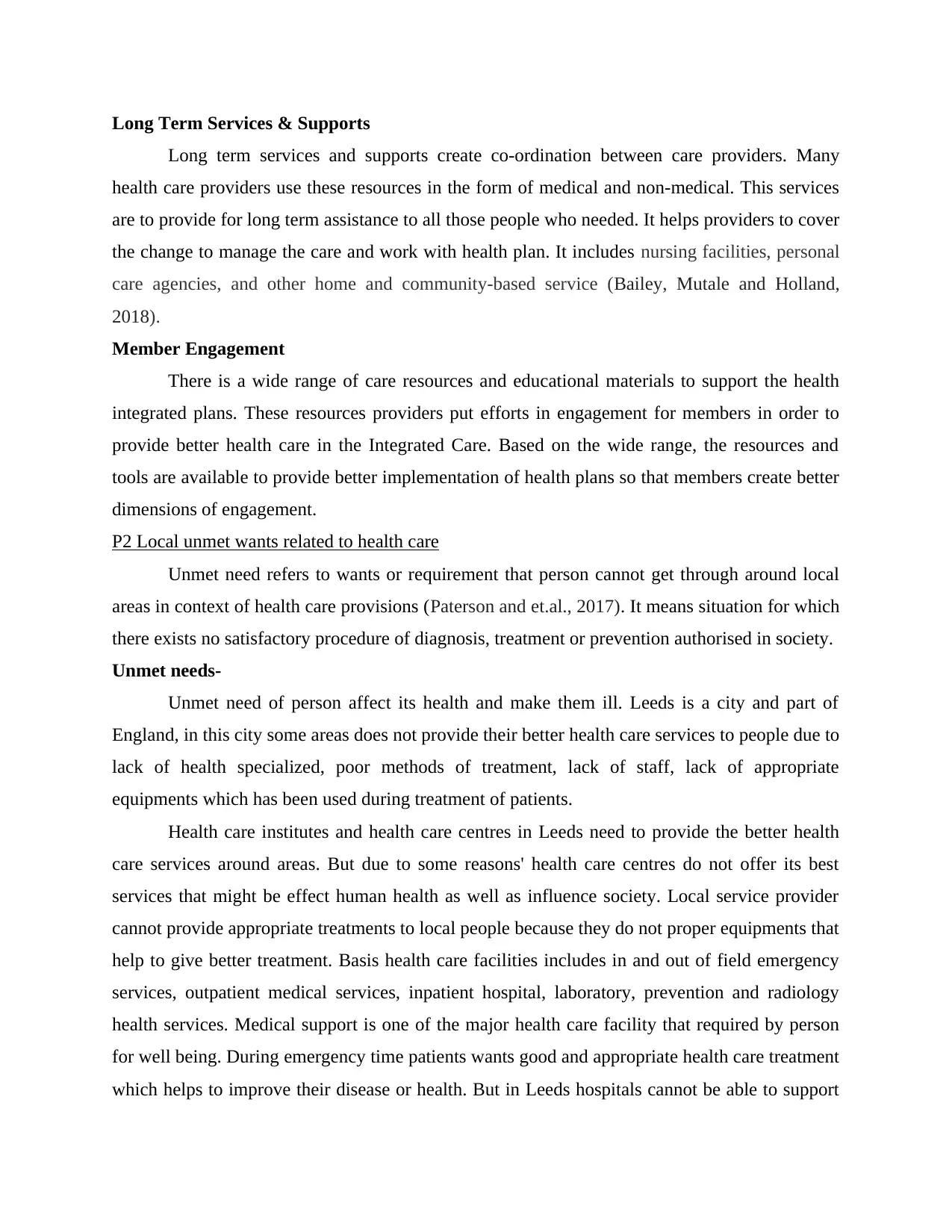
Long Term Services & Supports
Long term services and supports create co-ordination between care providers. Many
health care providers use these resources in the form of medical and non-medical. This services
are to provide for long term assistance to all those people who needed. It helps providers to cover
the change to manage the care and work with health plan. It includes nursing facilities, personal
care agencies, and other home and community-based service (Bailey, Mutale and Holland,
2018).
Member Engagement
There is a wide range of care resources and educational materials to support the health
integrated plans. These resources providers put efforts in engagement for members in order to
provide better health care in the Integrated Care. Based on the wide range, the resources and
tools are available to provide better implementation of health plans so that members create better
dimensions of engagement.
P2 Local unmet wants related to health care
Unmet need refers to wants or requirement that person cannot get through around local
areas in context of health care provisions (Paterson and et.al., 2017). It means situation for which
there exists no satisfactory procedure of diagnosis, treatment or prevention authorised in society.
Unmet needs-
Unmet need of person affect its health and make them ill. Leeds is a city and part of
England, in this city some areas does not provide their better health care services to people due to
lack of health specialized, poor methods of treatment, lack of staff, lack of appropriate
equipments which has been used during treatment of patients.
Health care institutes and health care centres in Leeds need to provide the better health
care services around areas. But due to some reasons' health care centres do not offer its best
services that might be effect human health as well as influence society. Local service provider
cannot provide appropriate treatments to local people because they do not proper equipments that
help to give better treatment. Basis health care facilities includes in and out of field emergency
services, outpatient medical services, inpatient hospital, laboratory, prevention and radiology
health services. Medical support is one of the major health care facility that required by person
for well being. During emergency time patients wants good and appropriate health care treatment
which helps to improve their disease or health. But in Leeds hospitals cannot be able to support
Long term services and supports create co-ordination between care providers. Many
health care providers use these resources in the form of medical and non-medical. This services
are to provide for long term assistance to all those people who needed. It helps providers to cover
the change to manage the care and work with health plan. It includes nursing facilities, personal
care agencies, and other home and community-based service (Bailey, Mutale and Holland,
2018).
Member Engagement
There is a wide range of care resources and educational materials to support the health
integrated plans. These resources providers put efforts in engagement for members in order to
provide better health care in the Integrated Care. Based on the wide range, the resources and
tools are available to provide better implementation of health plans so that members create better
dimensions of engagement.
P2 Local unmet wants related to health care
Unmet need refers to wants or requirement that person cannot get through around local
areas in context of health care provisions (Paterson and et.al., 2017). It means situation for which
there exists no satisfactory procedure of diagnosis, treatment or prevention authorised in society.
Unmet needs-
Unmet need of person affect its health and make them ill. Leeds is a city and part of
England, in this city some areas does not provide their better health care services to people due to
lack of health specialized, poor methods of treatment, lack of staff, lack of appropriate
equipments which has been used during treatment of patients.
Health care institutes and health care centres in Leeds need to provide the better health
care services around areas. But due to some reasons' health care centres do not offer its best
services that might be effect human health as well as influence society. Local service provider
cannot provide appropriate treatments to local people because they do not proper equipments that
help to give better treatment. Basis health care facilities includes in and out of field emergency
services, outpatient medical services, inpatient hospital, laboratory, prevention and radiology
health services. Medical support is one of the major health care facility that required by person
for well being. During emergency time patients wants good and appropriate health care treatment
which helps to improve their disease or health. But in Leeds hospitals cannot be able to support
Paraphrase This Document
Need a fresh take? Get an instant paraphrase of this document with our AI Paraphraser
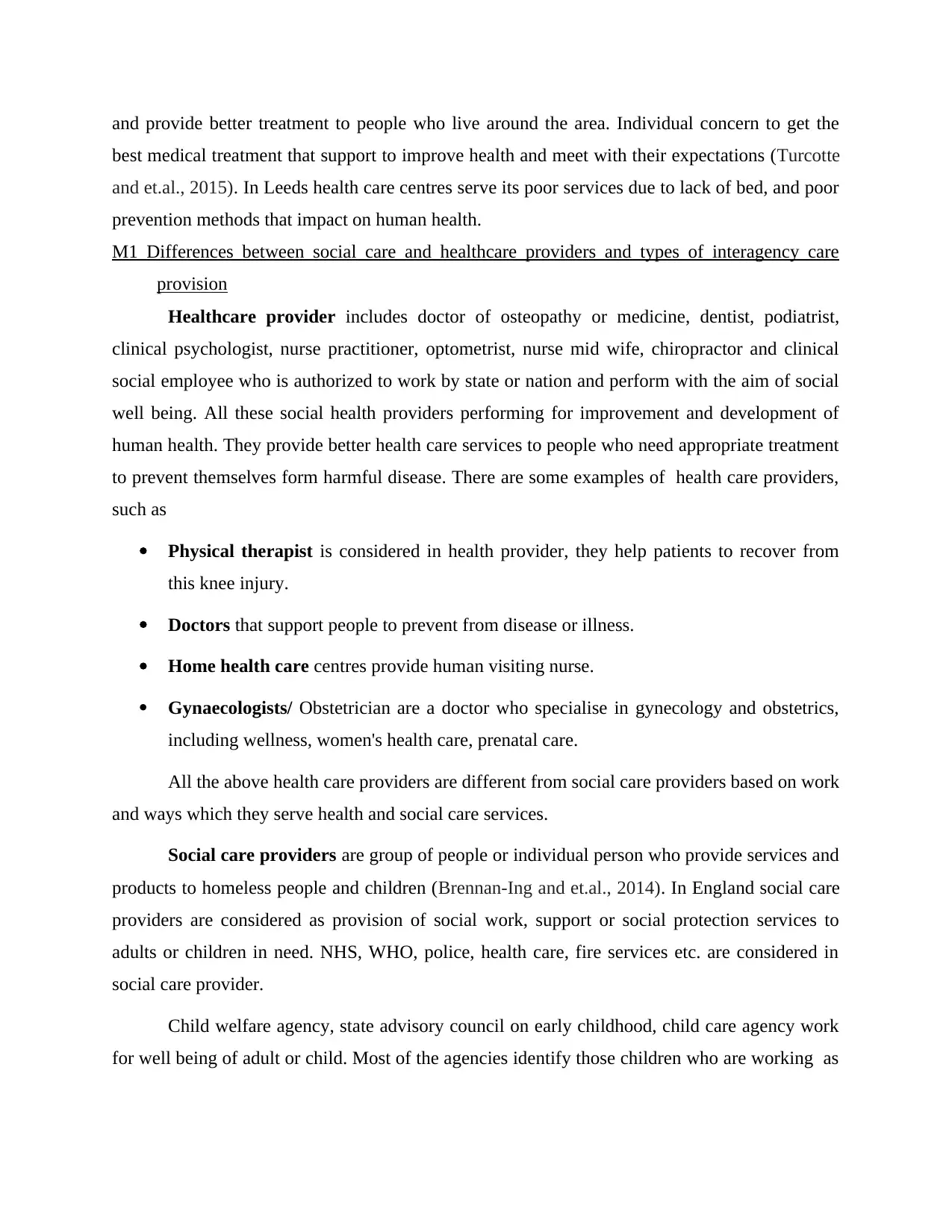
and provide better treatment to people who live around the area. Individual concern to get the
best medical treatment that support to improve health and meet with their expectations (Turcotte
and et.al., 2015). In Leeds health care centres serve its poor services due to lack of bed, and poor
prevention methods that impact on human health.
M1 Differences between social care and healthcare providers and types of interagency care
provision
Healthcare provider includes doctor of osteopathy or medicine, dentist, podiatrist,
clinical psychologist, nurse practitioner, optometrist, nurse mid wife, chiropractor and clinical
social employee who is authorized to work by state or nation and perform with the aim of social
well being. All these social health providers performing for improvement and development of
human health. They provide better health care services to people who need appropriate treatment
to prevent themselves form harmful disease. There are some examples of health care providers,
such as
Physical therapist is considered in health provider, they help patients to recover from
this knee injury.
Doctors that support people to prevent from disease or illness.
Home health care centres provide human visiting nurse.
Gynaecologists/ Obstetrician are a doctor who specialise in gynecology and obstetrics,
including wellness, women's health care, prenatal care.
All the above health care providers are different from social care providers based on work
and ways which they serve health and social care services.
Social care providers are group of people or individual person who provide services and
products to homeless people and children (Brennan-Ing and et.al., 2014). In England social care
providers are considered as provision of social work, support or social protection services to
adults or children in need. NHS, WHO, police, health care, fire services etc. are considered in
social care provider.
Child welfare agency, state advisory council on early childhood, child care agency work
for well being of adult or child. Most of the agencies identify those children who are working as
best medical treatment that support to improve health and meet with their expectations (Turcotte
and et.al., 2015). In Leeds health care centres serve its poor services due to lack of bed, and poor
prevention methods that impact on human health.
M1 Differences between social care and healthcare providers and types of interagency care
provision
Healthcare provider includes doctor of osteopathy or medicine, dentist, podiatrist,
clinical psychologist, nurse practitioner, optometrist, nurse mid wife, chiropractor and clinical
social employee who is authorized to work by state or nation and perform with the aim of social
well being. All these social health providers performing for improvement and development of
human health. They provide better health care services to people who need appropriate treatment
to prevent themselves form harmful disease. There are some examples of health care providers,
such as
Physical therapist is considered in health provider, they help patients to recover from
this knee injury.
Doctors that support people to prevent from disease or illness.
Home health care centres provide human visiting nurse.
Gynaecologists/ Obstetrician are a doctor who specialise in gynecology and obstetrics,
including wellness, women's health care, prenatal care.
All the above health care providers are different from social care providers based on work
and ways which they serve health and social care services.
Social care providers are group of people or individual person who provide services and
products to homeless people and children (Brennan-Ing and et.al., 2014). In England social care
providers are considered as provision of social work, support or social protection services to
adults or children in need. NHS, WHO, police, health care, fire services etc. are considered in
social care provider.
Child welfare agency, state advisory council on early childhood, child care agency work
for well being of adult or child. Most of the agencies identify those children who are working as
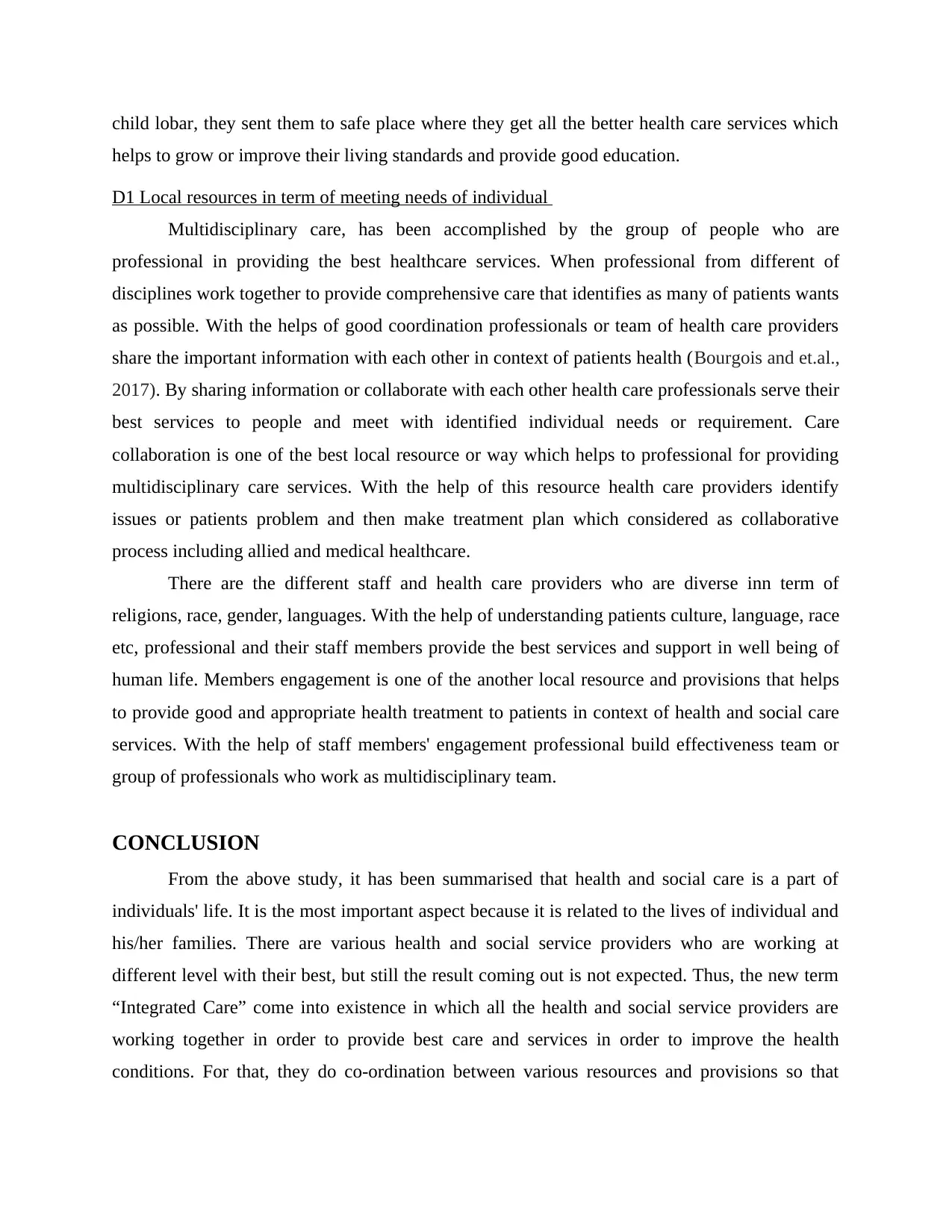
child lobar, they sent them to safe place where they get all the better health care services which
helps to grow or improve their living standards and provide good education.
D1 Local resources in term of meeting needs of individual
Multidisciplinary care, has been accomplished by the group of people who are
professional in providing the best healthcare services. When professional from different of
disciplines work together to provide comprehensive care that identifies as many of patients wants
as possible. With the helps of good coordination professionals or team of health care providers
share the important information with each other in context of patients health (Bourgois and et.al.,
2017). By sharing information or collaborate with each other health care professionals serve their
best services to people and meet with identified individual needs or requirement. Care
collaboration is one of the best local resource or way which helps to professional for providing
multidisciplinary care services. With the help of this resource health care providers identify
issues or patients problem and then make treatment plan which considered as collaborative
process including allied and medical healthcare.
There are the different staff and health care providers who are diverse inn term of
religions, race, gender, languages. With the help of understanding patients culture, language, race
etc, professional and their staff members provide the best services and support in well being of
human life. Members engagement is one of the another local resource and provisions that helps
to provide good and appropriate health treatment to patients in context of health and social care
services. With the help of staff members' engagement professional build effectiveness team or
group of professionals who work as multidisciplinary team.
CONCLUSION
From the above study, it has been summarised that health and social care is a part of
individuals' life. It is the most important aspect because it is related to the lives of individual and
his/her families. There are various health and social service providers who are working at
different level with their best, but still the result coming out is not expected. Thus, the new term
“Integrated Care” come into existence in which all the health and social service providers are
working together in order to provide best care and services in order to improve the health
conditions. For that, they do co-ordination between various resources and provisions so that
helps to grow or improve their living standards and provide good education.
D1 Local resources in term of meeting needs of individual
Multidisciplinary care, has been accomplished by the group of people who are
professional in providing the best healthcare services. When professional from different of
disciplines work together to provide comprehensive care that identifies as many of patients wants
as possible. With the helps of good coordination professionals or team of health care providers
share the important information with each other in context of patients health (Bourgois and et.al.,
2017). By sharing information or collaborate with each other health care professionals serve their
best services to people and meet with identified individual needs or requirement. Care
collaboration is one of the best local resource or way which helps to professional for providing
multidisciplinary care services. With the help of this resource health care providers identify
issues or patients problem and then make treatment plan which considered as collaborative
process including allied and medical healthcare.
There are the different staff and health care providers who are diverse inn term of
religions, race, gender, languages. With the help of understanding patients culture, language, race
etc, professional and their staff members provide the best services and support in well being of
human life. Members engagement is one of the another local resource and provisions that helps
to provide good and appropriate health treatment to patients in context of health and social care
services. With the help of staff members' engagement professional build effectiveness team or
group of professionals who work as multidisciplinary team.
CONCLUSION
From the above study, it has been summarised that health and social care is a part of
individuals' life. It is the most important aspect because it is related to the lives of individual and
his/her families. There are various health and social service providers who are working at
different level with their best, but still the result coming out is not expected. Thus, the new term
“Integrated Care” come into existence in which all the health and social service providers are
working together in order to provide best care and services in order to improve the health
conditions. For that, they do co-ordination between various resources and provisions so that
⊘ This is a preview!⊘
Do you want full access?
Subscribe today to unlock all pages.

Trusted by 1+ million students worldwide

health plan could become successful and could fulfil the unmeet needs of the people who
required health and social service care.
required health and social service care.
Paraphrase This Document
Need a fresh take? Get an instant paraphrase of this document with our AI Paraphraser
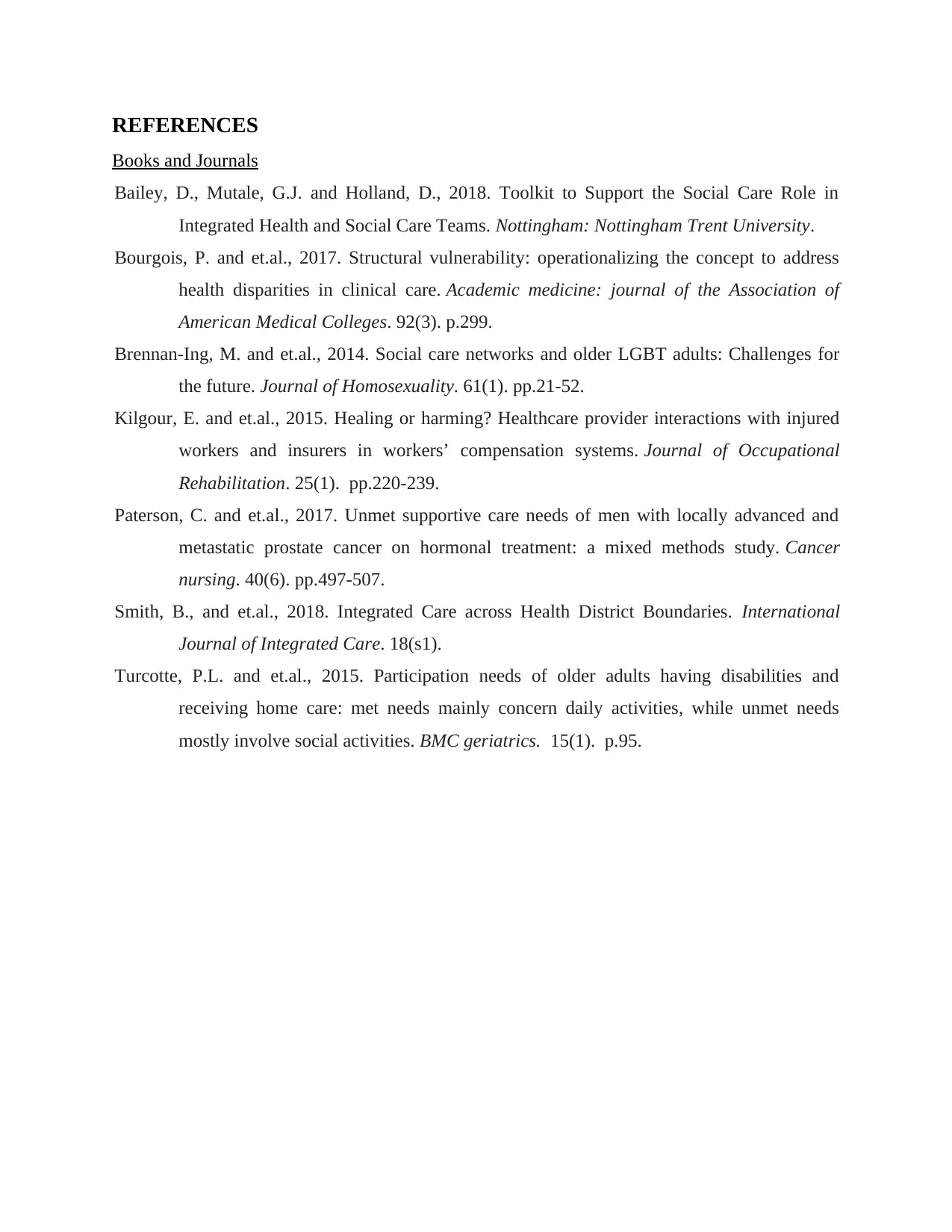
REFERENCES
Books and Journals
Bailey, D., Mutale, G.J. and Holland, D., 2018. Toolkit to Support the Social Care Role in
Integrated Health and Social Care Teams. Nottingham: Nottingham Trent University.
Bourgois, P. and et.al., 2017. Structural vulnerability: operationalizing the concept to address
health disparities in clinical care. Academic medicine: journal of the Association of
American Medical Colleges. 92(3). p.299.
Brennan-Ing, M. and et.al., 2014. Social care networks and older LGBT adults: Challenges for
the future. Journal of Homosexuality. 61(1). pp.21-52.
Kilgour, E. and et.al., 2015. Healing or harming? Healthcare provider interactions with injured
workers and insurers in workers’ compensation systems. Journal of Occupational
Rehabilitation. 25(1). pp.220-239.
Paterson, C. and et.al., 2017. Unmet supportive care needs of men with locally advanced and
metastatic prostate cancer on hormonal treatment: a mixed methods study. Cancer
nursing. 40(6). pp.497-507.
Smith, B., and et.al., 2018. Integrated Care across Health District Boundaries. International
Journal of Integrated Care. 18(s1).
Turcotte, P.L. and et.al., 2015. Participation needs of older adults having disabilities and
receiving home care: met needs mainly concern daily activities, while unmet needs
mostly involve social activities. BMC geriatrics. 15(1). p.95.
Books and Journals
Bailey, D., Mutale, G.J. and Holland, D., 2018. Toolkit to Support the Social Care Role in
Integrated Health and Social Care Teams. Nottingham: Nottingham Trent University.
Bourgois, P. and et.al., 2017. Structural vulnerability: operationalizing the concept to address
health disparities in clinical care. Academic medicine: journal of the Association of
American Medical Colleges. 92(3). p.299.
Brennan-Ing, M. and et.al., 2014. Social care networks and older LGBT adults: Challenges for
the future. Journal of Homosexuality. 61(1). pp.21-52.
Kilgour, E. and et.al., 2015. Healing or harming? Healthcare provider interactions with injured
workers and insurers in workers’ compensation systems. Journal of Occupational
Rehabilitation. 25(1). pp.220-239.
Paterson, C. and et.al., 2017. Unmet supportive care needs of men with locally advanced and
metastatic prostate cancer on hormonal treatment: a mixed methods study. Cancer
nursing. 40(6). pp.497-507.
Smith, B., and et.al., 2018. Integrated Care across Health District Boundaries. International
Journal of Integrated Care. 18(s1).
Turcotte, P.L. and et.al., 2015. Participation needs of older adults having disabilities and
receiving home care: met needs mainly concern daily activities, while unmet needs
mostly involve social activities. BMC geriatrics. 15(1). p.95.
1 out of 8
Related Documents
Your All-in-One AI-Powered Toolkit for Academic Success.
+13062052269
info@desklib.com
Available 24*7 on WhatsApp / Email
![[object Object]](/_next/static/media/star-bottom.7253800d.svg)
Unlock your academic potential
Copyright © 2020–2025 A2Z Services. All Rights Reserved. Developed and managed by ZUCOL.





